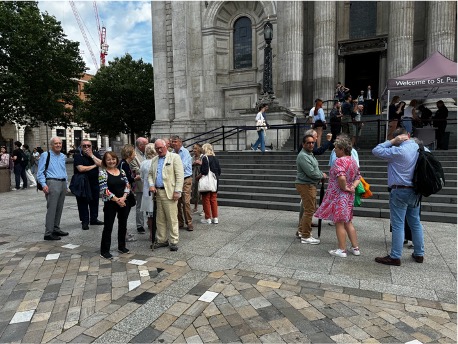
The Company’s annual Charter Day Visit to mark the 456th anniversary of the signing of the Company’s first Charter by Queen Elizabeth the First on 3rd August 1568.
This year’s Charter Day visit chosen by the Master was held on the exact anniversary date.
The Master accompanied by 23 Tylers and Bricklatyers together with their guests, enjoyed a fantastically interestng guided tour of just a few of the more than 300 hidden gardens of the City of London’s Square Mile.
Our guide was Christne Jarvis, a City of London Guide Lecturer and a Liveryman of the Water Conservators.
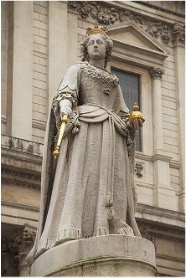
We met at St Pauls' Cathedral steps where Christne introduced us to the gin drinking habits of Queen Anne of whom a High Tory politcal opponent once wrote that;
"It was fittng she was depicted with her rump to the church, gazing longingly into a wineshop”.
The poor queen died in 1714 from contnued ill health and severe gout.
Across the road from St Paul’s in Carter Lane gardens we learnt of the use of Ginko trees which grow tall and thin and are being planted in the square mile as they don’t drop their leaves and can withstand the winds that the new high rise buildings create. The garden itself reflects the curved shape of the transept it faces and is watered using water collected from the roof of the cathedral.
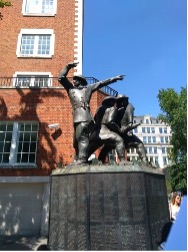
This is also the site of the Natonal Firefighters memorial. Initally, the memorial was for the men and women who lost their lives fightng the fires which were caused by the Blitz in the Second World War, when the city was bombed by the Nazis for 57 consecutve nights.
It was decided that the memorial would honour all firefighters throughout the UK who had been killed whilst doing their duty. The names of the 1,192 heroes were inscribed on plaques surrounding the monument in September 2003.
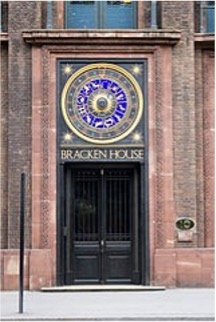
The group then proceeded to the reflection garden on the corner of Cannon Street, but we paused opposite Bracken House the former Financial Times building where we learned that colour of the brick was chosen as an allusion to the colour of the newspaper. Lord Bracken was a close friend of that very famous bricklayer, Sir Winston Churchill’s and Churchill’s face appears in the centre of the astrological clock which adorns the entrance to the building.
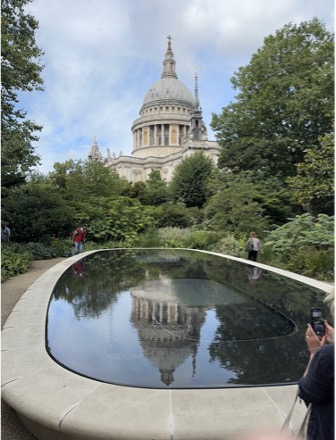
The reflection garden is quite a new additon to the city’s collecton, only opened to the public in 2022. It is designed to create a double view of the cathedral where one can sit in peaceful surroundings of sustainable planting. A space designed to attract birds bats and insects.
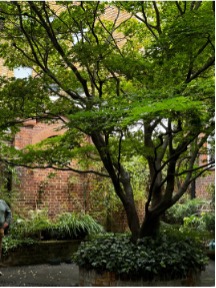
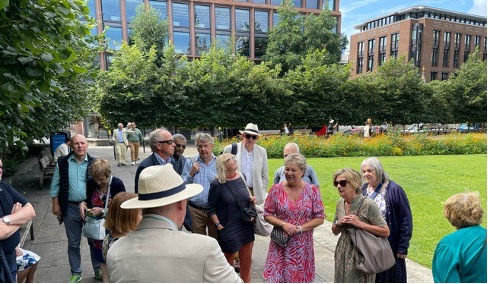
We then returned to the Cathedral grounds, passed through the Festival Gardens and were then regalled with tales of hanging drawing and quartering near the site of Pauls Cross while admiring the only Douglas Fir in the City of London. The Douglas Fir is named aber David Douglas a botanist who first introduced the tree to England in 1827.
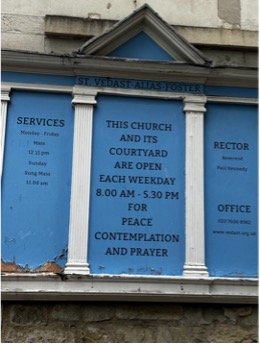
Pauls Cross was the most important public pulpit in Tudor and early Stuart England, and many of the most important statements on the political and religious changes brought about by the Reformation were made public from here. The pulpit stood in the Cross Yard, which is the open space on the north-east side of St Paul's Churchyard.
In Tudor times booksellers would bring their wares to sell on barrows but eventually these gave way to fixed stalls. The adjacent the row of buildings were developed and would become the home of London's publishing and book-selling trade.
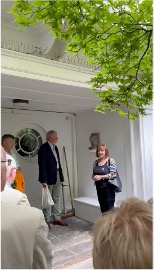
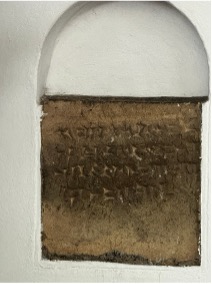
Our next move was to St Vedast-alias-Fisher. In it’s quiet pretty courtyard is an ancient cuneiform stone set in the wall This was from Assyrian tmes and was presented to Canon Mortlock by Agatha Christe and her husband Sir Max Mallowan for the Canon’s contribution to Mallowan’s dig in Iraq during 1950-1965, when the stone was found. Leaving St Vedast we arrived at a small courtyard which was all that is left of St Peter West Cheap following the great fire of London but which was never rebuilt. It is now home to a huge plane tree which is believed to be the oldest in the City. Cheap of course, is the medeival English name for market!
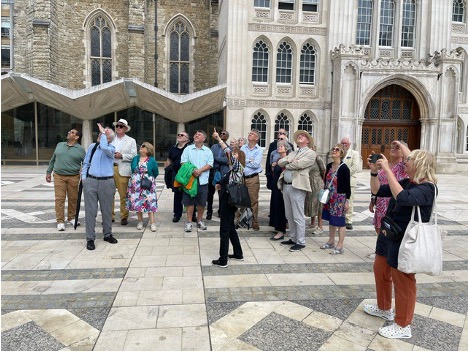
After a short stop at the Guildhall we passed to the ruins of St Mary Aldermanbury which was all but destroyed in the great fire, rebuilt by Wren and destroyed again in 1940.
The remaining fabric of the building was given to Westminster College in Fulton Missouri in 1966 and the Church was restored as new to commemorate Churchill’s Iron Curtain speech which he gave in the USA.
The gardens also house a monument to Henry Condell and John Heminges, key figures in the production of the first folio of William Shakespeare's plays as they were co-partners with him in the Globe Theatre. Condell and Heminges lived in the St Mary Aldermanbury parish and were buried in its churchyard. This monument is topped with a bust of Shakespeare.
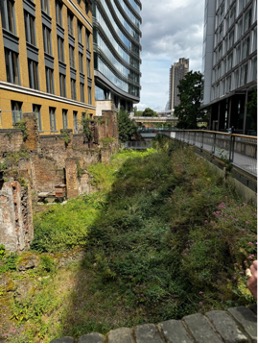
Our next garden demonstrates how the City is rewilding areas creating wildlife corridors and here at the rear of the Plasterer’s Hall, we visited the last bit of bomb damage in the city which is deliberately becoming a haven for wild plants insects and birds and animals
We can see the old and new in this photo with some Roman remains looking past the Foster building on the left through to the Barbican.
From here we walked to the Goldsmiths garden in the churchyard of St John Zachary. This was refurbished in 1994/5 mainly by the Gardeners Company with assistance of the lightmongers.
The garden contains the only statue dedicated to the printing industry in London.
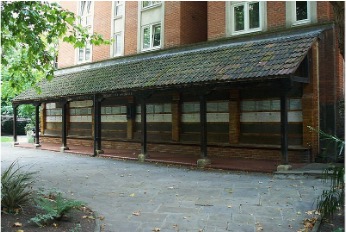
Then to our penultimate visit, The Postman’s Park where there is a memorial to heroic self sacrifice commemorating ordinary people who died saving the lives of others.
The park is also home to the City’s only Handkerchief tree.
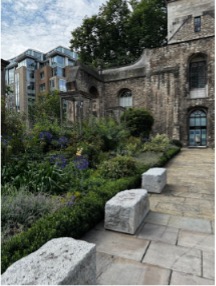
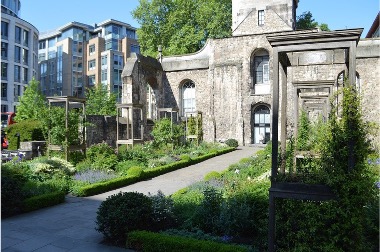
Our last garden was Christchurch Greyfriars. The church was bombed in in WW2 and has been replaced with a beautiful garden. Originally a rose garden it has more recently been re-designed to make it more sustainable as the soil was mostly too dry for cultivating roses.
The design represents the former church with the central pathway being the aisle leading to the altar and the beds either side being the pews. The square trellises represent the columns that supported the roof. it was a most enjoyable tour and we were very fortunate with the weather. The sun shone and it was not too hot. We all learnt many new facts about the City.
All were very impressed by Christine’s knowledge of both the City of London's history and the gardens we visited.
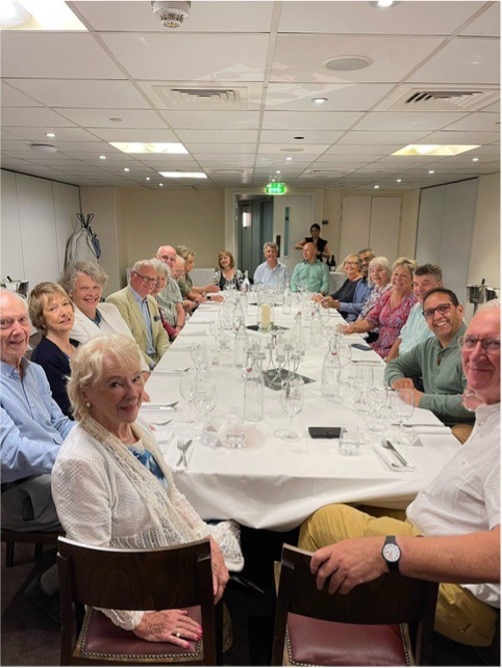
We were all now ready for a good lunch and relaxed conversation and repaired to Cote in Ludgate Hill. Many thanks to theMaster and to our guide Christine for an excellent Charter Day
Liveryman David Hulin
